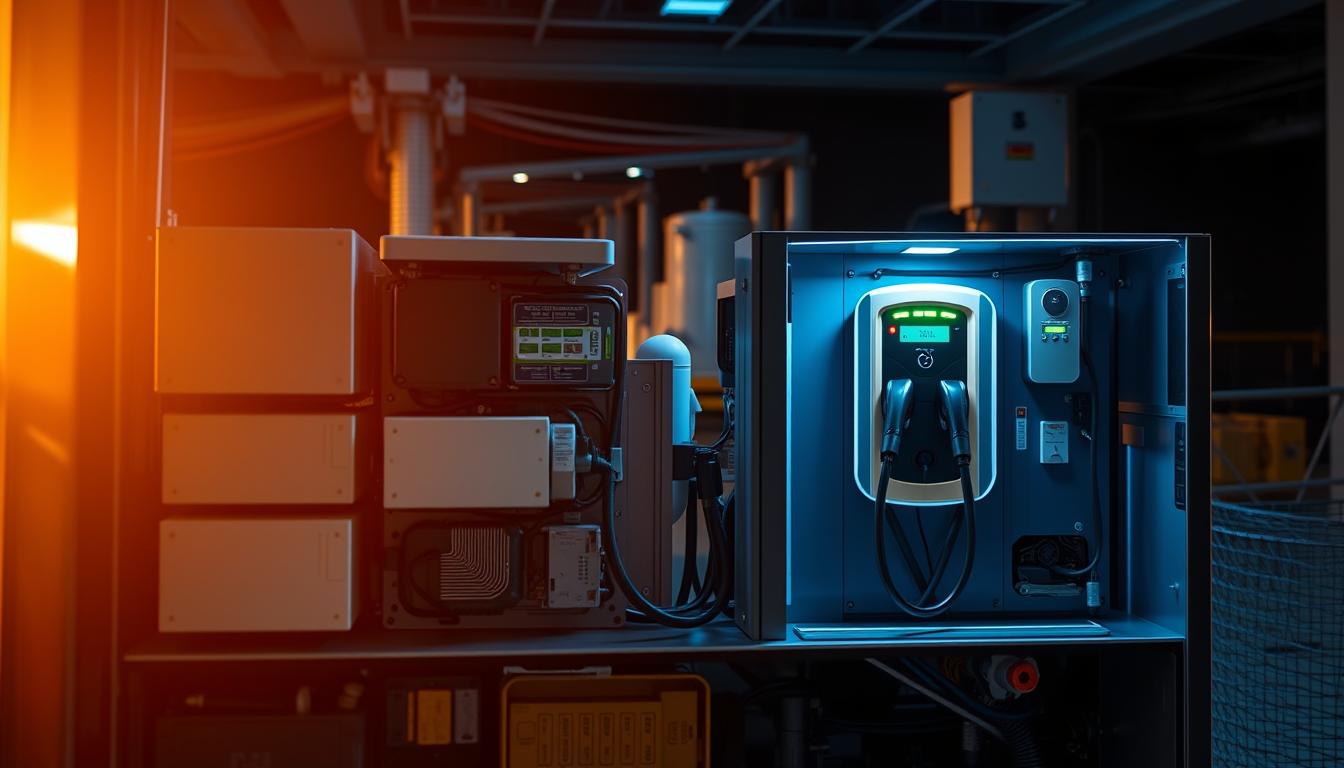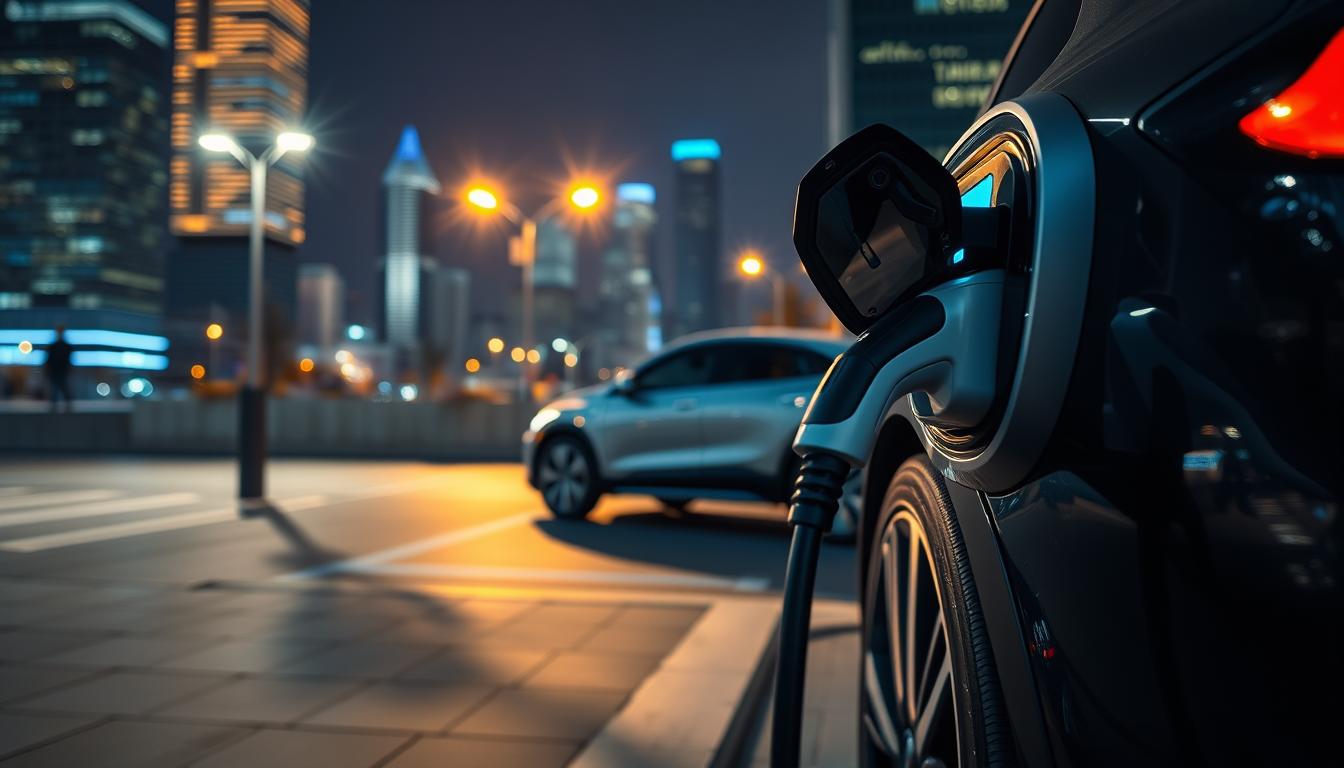The world is shifting towards sustainable transportation, and electric vehicles (EVs) are at the forefront of this change. With the number of EVs on the road expected to reach 14 million by 2025, the demand for electric vehicle charging infrastructure is skyrocketing.
So, how do electric vehicle charging stations work? Simply put, they supply electric energy to recharge EVs. The charging process involves converting AC power from the grid to DC power that the vehicle’s battery can use.
Key Takeaways
- Electric vehicle charging stations are crucial for the widespread adoption of EVs.
- The charging process involves converting AC to DC power.
- There are different types of charging stations, including Level 1, Level 2, and DC Fast Charging.
- Charging times vary significantly depending on the type of charger and vehicle.
- The expansion of charging infrastructure is key to supporting the growing number of EVs on the road.
The Basics of Electric Vehicle Charging
With the rise of electric vehicles, it’s essential to delve into the basics of EV charging infrastructure and technology. As the demand for electric vehicles continues to grow, so does the need for a comprehensive understanding of how EV charging works.
The Growing EV Charging Infrastructure in America
The United States has seen a significant expansion in its EV charging infrastructure over the past few years. This growth is driven by increasing demand for electric vehicles and government initiatives to support the adoption of EVs.
Key statistics highlighting the growth include:
- Over 20,000 public charging stations across the country
- A 40% increase in charging infrastructure in 2022 alone
- Major investments by companies like Tesla, ChargePoint, and EVgo
Understanding Electric Vehicle Battery Systems
Electric vehicle batteries are a crucial component of EVs, and understanding how they work is vital. Most EVs use lithium-ion battery systems, which are known for their high energy density and relatively long lifespan.
| Battery Type | Energy Density | Lifespan |
|---|---|---|
| Lithium-ion | High | Up to 300,000 miles |
| Nickel-Metal Hydride | Medium | Up to 100,000 miles |
Power Delivery: AC vs. DC Charging
There are two primary types of charging: AC (Alternating Current) and DC (Direct Current). Understanding the difference between them is crucial for comprehending how EV charging works.
AC Charging: AC charging is the most common type of charging, typically used for home charging. It converts AC power from the grid to DC power for the battery using an onboard converter.
DC Fast Charging: DC Fast Charging, on the other hand, converts AC power to DC power outside the vehicle, allowing for faster charging. This type is commonly found at public charging stations.
How Do Electric Car Charging Stations Work: Core Technology
The functionality of electric car charging stations is rooted in their core technological components. These stations are not just simple outlets; they are complex systems that manage the flow of electrical energy to charge electric vehicles efficiently and safely.

Essential Components of Charging Stations
Electric vehicle charging stations consist of several key components that work together to deliver power to the vehicle. These include the charging connector, power conversion unit, and the control system. The charging connector is the interface between the charging station and the vehicle, ensuring a secure and efficient transfer of energy.
Power Conversion and Management Systems
The power conversion unit is crucial for converting Alternating Current (AC) from the grid to Direct Current (DC) that the vehicle’s battery can use. Efficient power conversion is vital for fast and safe charging. Management systems oversee this process, ensuring that the energy transfer is optimized and that the vehicle’s battery is not overcharged or undercharged.
Communication Protocols Between Vehicle and Charger
Effective communication between the electric vehicle and the charging station is necessary for a smooth charging process. Communication protocols enable the exchange of information regarding the vehicle’s battery status, charging requirements, and the charging station’s capabilities. This ensures that the charging process is tailored to the vehicle’s needs, enhancing efficiency and safety.
Safety Features and Overcurrent Protection
Safety is a paramount concern in the design of electric vehicle charging stations. Safety features include overcurrent protection, which prevents damage to the vehicle and the charging station in case of an electrical surge. Grounding and insulation monitoring are other critical safety measures that protect users from electrical shock.
Types of EV Charging Stations and Their Capabilities
The electric vehicle (EV) charging landscape is diverse, offering various charging solutions to suit different needs. As electric vehicles become more mainstream, understanding the different types of charging stations is crucial for both current and prospective EV owners.
Level 1 Charging: Standard Household Outlets (120V)
Level 1 charging utilizes standard household outlets, providing 120 volts of power. This method is the most accessible but also the slowest, typically adding about 4 to 5 miles of range per hour of charging. It’s ideal for:
- Overnight charging at home
- Drivers with short commutes or those who don’t drive extensively
Level 2 Charging: Home and Public Stations (240V)
Level 2 charging stations operate at 240 volts, significantly faster than Level 1. They can add up to 25 miles of range per hour of charging. Level 2 charging is common in:
- Home installations for faster overnight charging
- Public charging stations in shopping centers, parking garages, and workplaces
Key benefits include: faster charging times and the ability to charge during the day while parked at work or while shopping.
DC Fast Charging: Rapid Power Delivery
DC Fast Charging is the quickest method, capable of delivering an 80% charge in under 30 minutes. It’s particularly useful for:
- Long-distance travelers needing rapid recharging
- High-traffic corridors and highways
Not all EVs are compatible with DC Fast Charging, so it’s essential to check your vehicle’s specifications.
Emerging Technologies: Wireless and Ultra-Fast Charging
The future of EV charging includes innovative technologies like wireless charging and ultra-fast charging. Wireless charging eliminates the need for cables, while ultra-fast charging can recharge batteries to 80% in under 15 minutes. These advancements are poised to:
- Enhance user convenience
- Reduce charging times further
As the EV landscape continues to evolve, staying informed about the various charging options and their capabilities will help users make the most of their electric vehicles.
Using and Finding EV Charging Infrastructure
To make the most out of electric vehicle ownership, it’s essential to know how to navigate the EV charging infrastructure. The United States has seen a significant expansion in its EV charging network, making it easier for drivers to find charging stations.
Major Charging Networks in the United States
The U.S. is home to several major EV charging networks that provide extensive coverage across the country. Some of the prominent networks include:
- ChargePoint: With over 24,000 charging stations, ChargePoint is one of the largest EV charging networks.
- EVgo: EVgo offers fast charging services and has a significant presence in many states.
- Tesla Supercharger: Although exclusive to Tesla vehicles, the Tesla Supercharger network is vast and continues to grow.
These networks often provide mobile apps that help drivers locate charging stations, check availability, and even pay for charging services.
Home Charging Solutions and Installation
For many EV owners, home charging is the most convenient option. Level 2 charging stations, which use 240V outlets, are popular for home installation because they charge vehicles faster than standard Level 1 chargers.
When considering home charging solutions, it’s crucial to:
- Assess your home’s electrical capacity.
- Choose a charger that fits your needs and budget.
- Hire a certified electrician for the installation.
The Charging Process: Step-by-Step Guide
Charging your electric vehicle is a straightforward process:
- Step 1: Locate a charging station near you using a mobile app or online map.
- Step 2: Check the type of connector the station uses and ensure your vehicle is compatible.
- Step 3: Plug in your vehicle and initiate the charging process through the station’s interface or your vehicle’s controls.
- Step 4: Monitor the charging progress, either on the charging station or through your vehicle’s dashboard.
Planning Long Trips with EV Charging Stops
Planning is key to successful long-distance EV travel. Here’s a simple table to help you understand the factors to consider:
| Trip Planning Factor | Description | Tips |
|---|---|---|
| Route Planning | Identify charging stations along your route. | Use online tools or apps to map out charging stops. |
| Charging Time | Consider the time spent charging. | Opt for DC Fast Charging for quicker stops. |
| Vehicle Range | Understand your vehicle’s range and limitations. | Check your vehicle’s battery level and adjust your route accordingly. |
By understanding the EV charging infrastructure and planning accordingly, you can enjoy a seamless driving experience.
Conclusion
Electric car charging stations are revolutionizing the way we think about transportation, making it easier to own and operate electric vehicles (EVs). As discussed, the process of how do electric car charging stations work involves a complex interplay of technology and infrastructure.
The various types of EV charging stations, including Level 1, Level 2, and DC Fast Charging, offer different capabilities and charging speeds. Understanding these differences is crucial for EV owners to make informed decisions about their charging needs.
As the EV market continues to grow, the infrastructure supporting it is also expanding. Major charging networks in the United States, such as Tesla’s Supercharger network and Electrify America, are playing a vital role in making long-distance EV travel more practical.
In conclusion, electric car charging stations are a critical component of the EV ecosystem. By understanding how they work and the options available, EV owners can maximize their vehicle’s potential and contribute to a more sustainable transportation future.
FAQ
How do electric car charging stations work?
Electric car charging stations work by supplying electric energy to recharge electric vehicles. They come in different types, including Level 1, Level 2, and DC Fast Charging, each with its own charging speed and power delivery method.
What is the difference between AC and DC charging?
AC (Alternating Current) charging uses the alternating current from the grid to charge the vehicle’s battery, whereas DC (Direct Current) charging converts the AC power from the grid to DC power before charging the battery, allowing for faster charging.
How long does it take to charge an electric vehicle?
The time it takes to charge an electric vehicle depends on the type of charging station used, the capacity of the vehicle’s battery, and the level of charge desired. Level 1 charging can take several hours, while DC Fast Charging can charge a vehicle to 80% in under 30 minutes.
Can I charge my electric vehicle at home?
Yes, you can charge your electric vehicle at home using a Level 1 or Level 2 charging station. Level 1 charging uses a standard household outlet, while Level 2 charging requires a 240-volt charging station to be installed.
How do I find electric vehicle charging stations?
You can find electric vehicle charging stations using online maps and directories provided by charging networks such as ChargePoint, EVgo, or through your vehicle’s built-in navigation system.
Are electric vehicle charging stations safe?
Yes, electric vehicle charging stations are designed with multiple safety features, including overcurrent protection, to ensure safe and reliable charging.
Can I use any charging station with my electric vehicle?
Most electric vehicles can use most charging stations, but it’s essential to check the connector type and the vehicle’s compatibility with the charging station’s power output.
What is the future of electric vehicle charging infrastructure?
The future of electric vehicle charging infrastructure includes advancements in wireless charging, ultra-fast charging, and the expansion of charging networks to support the growing number of electric vehicles on the road.




